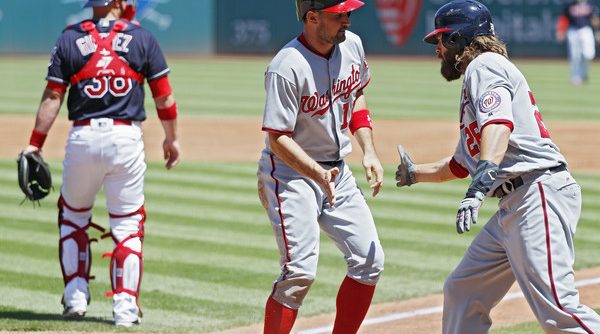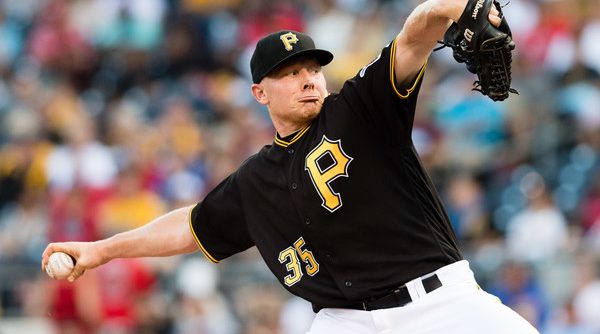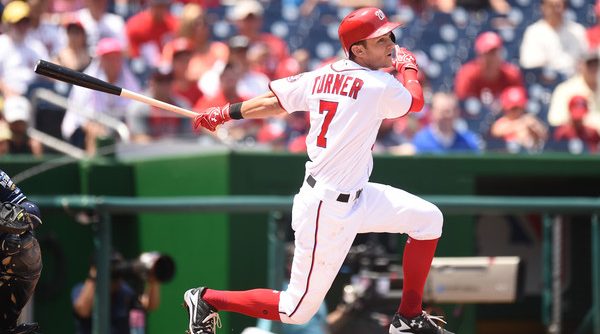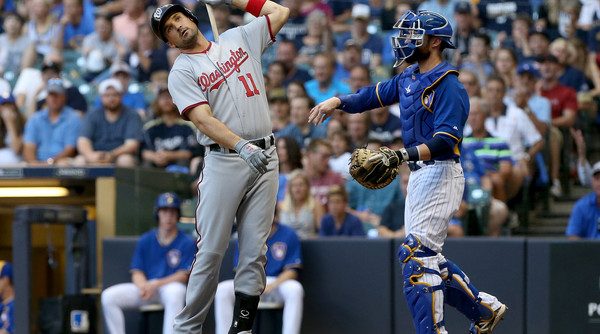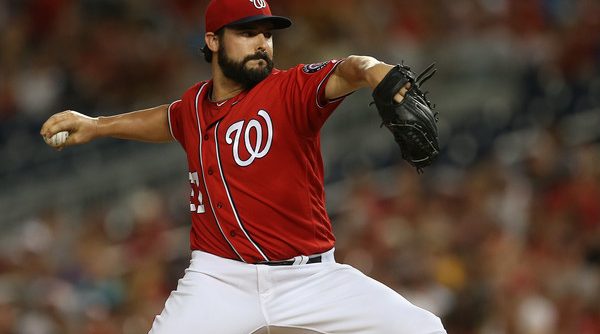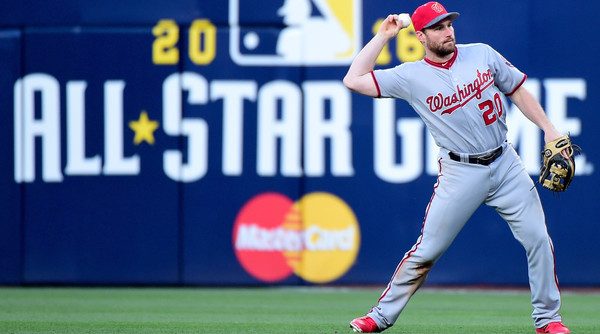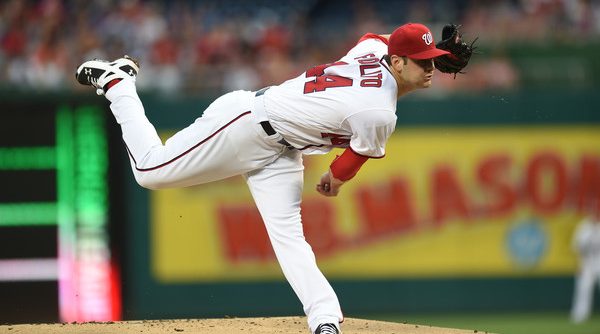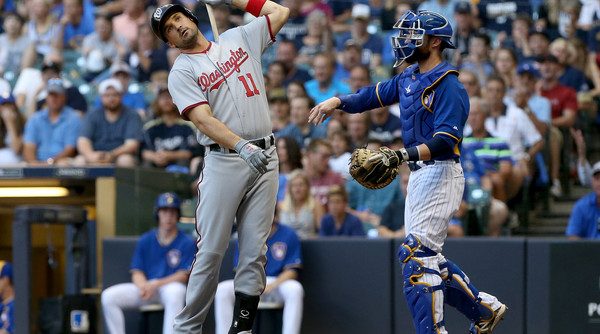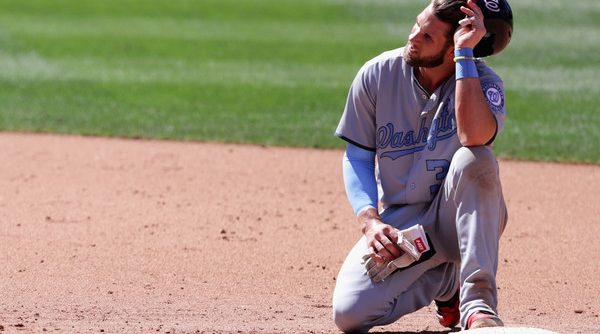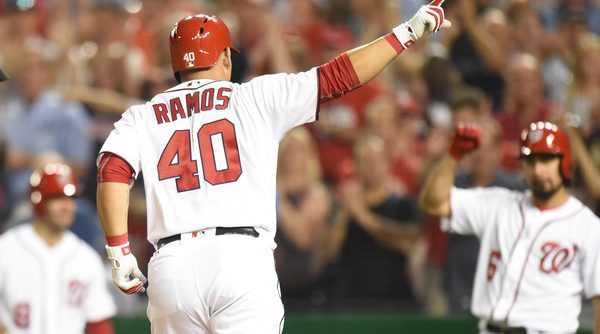Since Frank kicked off “feel good about the Nationals week,” I figured I would keep the good times rolling. While he talked about how the Nationals are in prime position to lock up the NL East and a playoff spot, I’m just here to make to tell you the Nationals are a good team. Period.
Getting to Know Mark Melancon
After weeks of speculation, the Nationals finally made a deal for a closer, a deal that fans had been demanding for quite a while. Except the deal wasn’t for either of the Yankees’ hard throwing lefties, Aroldis Chapman and Andrew Miller. It wasn’t for Royals closer extraordinaire Wade Davis either. Instead, it was for Mark Melancon in a deal that at worst looks like a fair trade but at best could be considered a borderline steal. Melancon’s name wasn’t making the rounds on the rumor mill for long before the deal got announced. So who exactly is the Nationals’ new closer?
The Nats’ New-Look Lineup Pays Off
The Nationals lost Tuesday night. Hold your vitriol for a moment, though, there is at least one positive to take out of the game. Before getting to the positive, let’s start with a few caveats. “Optimal” batting orders can mean something like 10-20 extra runs per season, one to two wins at best. The Nationals are on the road against the Indians, meaning the pitcher doesn’t hit and the Nationals get some extra lineup flexibility with a DH in the lineup. Finally, Dusty won’t commit to Tuesday night’s lineup long term.
But man, I loved the Tuesday night lineup. Here is why, on a position-by-position review:
How Can the Nationals Upgrade?
The trade deadline is approaching. #Sources are going to be trending on Twitter soon. Jon Heyman knock-off Twitter handles are primed to break fake news stories. The hot stove hasn’t really gotten going yet, but already the Nationals have been named as potential suitors for a whole host of players. As a team in the playoff hunt, it’s natural for people to speculate about what upgrades Mike Rizzo might make to his roster. But the Nationals are a first-place team, so where exactly could Rizzo try to improve the ball club?
Tanner Roark’s Elite Skill
Against a tough Pirates squad looking to fight their way back into the playoff picture, Tanner Roark turned in yet another impressive outing Saturday night. Although he couldn’t quite go the distance, he did turn in eight scoreless innings in the Nationals’ win. The Pirates struggled to even put together anything that could resemble a rally while Roark was on the mound. Pittsburgh can at least take some solace in the fact that they haven’t been the only team to struggle against Roark in 2016. He’s been on a tear since his first outing in 2016 and now holds an ERA under 3.00.
Over- and Under-Performers in the First Half
The All Star Game has come and gone and the Nationals kick off the second half of the season with an impressive six-game lead in the NL East. There have been a lot of ups and downs getting to that six game lead. Some players have clearly gone above and beyond expectations while others have frustratingly fallen short. Let’s figure out who those under/over performers are so far this Nationals season.
Continue Reading Over- and Under-Performers in the First Half
Giolito’s Big Debut
The Nationals have a thing about calling up stud pitching prospects on Tuesdays in June. The OG of Nats pitching prospects, Stephen Strasburg, set the bar pretty high for MLB debuts. He went seven innings, had 14 sensational strikeouts against the Pittsburgh Pirates and allowed only two runs, both coming on a two-run home run. Despite a one-hour rain delay to start of the game, Lucas Giolito, the next Nats hyped pitching prospect, lived up to Strasburg’s lofty precedent before his night was cut short by yet another rain delay.
Mythbusting Zimmerman’s Bases-Loaded Struggles
In Saturday’s loss against the Brewers, Ryan Zimmerman hit a sacrifice fly with the bases loaded, which means he didn’t get a hit in yet another high leverage situation this season. Despite flashes here and there, Zimmerman has struggled offensively this season. Those struggles have been exposed in high leverage situations thanks to the new found strategy of intentionally walking whoever hits in front of Zimmerman. Joe Maddon may have some creative get-away outfit ideas, but as a Nats fan I’ll take a hard pass on his trend setting idea of walking Bryce Harper to get to Zimmerman. That means he has had his fair share of bases loaded chances and has failed to really deliver on those opportunities. How bad has it been? Let’s take a look.
Continue Reading Mythbusting Zimmerman’s Bases-Loaded Struggles
Is Bryce Harper OK?
I had the pleasure of being in San Diego this weekend for the Nationals’ series with the Padres. In the midst of Saturday night’s game, though, my enjoyment of the beautiful weather, scenic ballpark and momentary Nationals’ lead was shattered by a gentleman sitting behind me in a Padres jersey. This gentleman, you see, was talking smack about Bryce Harper. Now, I enjoy good smack talk, even if it’s about Nationals players. But it has to be smart smack talk. This particular Padres’ fan was comparing Bryce Harper to Mattt Kemp because, as he put it, they both are hitting .250 and Kemp has hit more home runs. You will be proud to hear, The Nats Blog readers, that I didn’t react with anger or aggression at this mistaken Padres’ fan, although I really wanted to. No, I did what any good millennial would do and tweeted about it instead.
It’s taking superhuman strength to not turn around and correct the Padres fan behind me who thinks Harper is overrated
— Joseph Seib (@seibj10) June 19, 2016
Now, this anonymous Padres fan wasn’t wrong in citing Harper’s batting average and home run total in the sense that he obviously had those stats correct. What he missed and what got me upset is that said Padres fan didn’t see or didn’t understand the bigger picture. Thanks to Harper’s .406 on base percentage (a higher OBP than Daniel Murphy, owner of a .367 batting average, by the way) he’s still a top 30 player in all of baseball by FanGraphs’ WAR. Matt Kemp, the comparable player in the eyes of everyone’s favorite Padres fan, has only a .274 OBP. Combine that with terrible defense in right field and he has actually been worth negative WAR. So take that, Padres fan!
There is some bad news, though. Since the Cubs series when Joe Maddon infamously intentionally walked Bryce 173* times (*estimated), Harper has been struggling. He’s hit for only a .246 batting average since that May series with an ISO of .127 — more fitting for Ben Revere than Harper. He’s been tentative on pitches in the zone, swinging at fewer pitches in the strike zone than ever before. Bryce is making more soft contact than normal and hitting more ground balls as a result. Especially concerning, he’s struggling to handle four seam fastballs. After hitting .322 against four seamers in 2015, Harper is struggling to a .189 batting average against the pitch. What’s more, it looks like pitchers have found an area of the zone to attack Harper: up and away. Harper is very obviously a low ball hitter, so pitchers usually keep fastballs up in the zone against Bryce. Since that Cubs series, though, they have focused on the outer corner of zone with the hard stuff (graphic courtesy of BaseballSavant.com):
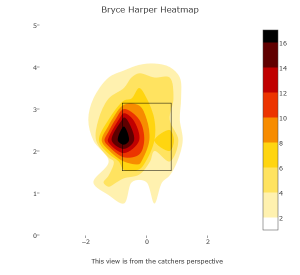
And pitchers have been successful doing so, as Harper’s sub .200 batting average suggests.
Ready for the good news? There are signs to suggest that this is a temporary slump and Bryce is close to turning things around. The biggest sign is that Bryce is not chasing pitches out of the zone, pressing to get out of his slump as he has done in the past. In fact, he’s swinging at noticeably fewer pitches out of the strike zone and cut down on his total swing and miss rate. As a result, his OBP is still stellar, which means he’s still getting on base at close to a .400 rate in the midst of this slump. On top of that, Harper’s BABIP is a career-worst .260, miles off of his career rate of .322 and his .369 BABIP last year, so he’s been on the wrong end of some batted ball luck. On top of all that, Harper’s struggles with fastballs up in the zone are new thing this year. Last season, although he was a better hitter against pitches down in the zone, he still hit for a solid average against fastballs up in the zone.
It doesn’t seem likely that the league has found some huge hole in Harper’s swing and has solved the puzzle of how to pitch to Bryce Harper. In fact, the Padres found out how attempting to attack Harper up in the zone with fastballs can backfire. Thursday night, Erik Johnson followed his scouting report and threw a fastball in the upper corner of the zone. Johnson made the pitch he wanted:
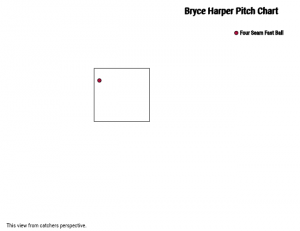
Instead of flailing away, Harper drilled it down the left field line for a home run.
Yes, Bryce has been in a slump. Yes, the league has found a short term plan of attack that has been successful against Harper. Yes, Bryce has been tentative and hasn’t been able to square up the ball as consistently as fans are used to. But he’s clearly gotten some bad bounces. He’s not swinging and missing more. And he’s adjusted to the league’s new approach against him. If opposing teams are willing to keep betting that Harper will struggle against fastballs, Nats fans should be happy to be on the other end of that wager.
Wilson Ramos Is Seeing the Light
Only a few months ago, large portions of the Nationals’ fan base were coming up with ways to ship Wilson Ramos out of DC and drawing up fictitious trade proposals for the Brewers’ Jonathan Lucroy to “upgrade” the catcher position. It’s hard to blame them. Although Ramos was finally able to stay healthy in 2015, he posted the worst offensive season of his career and one of the least valuable seasons from a catcher in all of baseball. I would assume that those disbelievers have now seen the light as Ramos has turned into one of the most potent players in the big leagues in 2016, including a game-tying single in the ninth in Wednesday’s win over the Cubs.
So far this season, he leads nearly every major offensive category for catchers. He’s first in batting average, on base percentage, slugging, wOBA, home runs and RBI. He’s second in FanGraphs’ WAR calculation (behind Lucroy). You would be hard pressed to find an offensive statistic where Ramos isn’t one of the top catchers in the league. The narrative as to why Ramos has rebounded so well isn’t hard to see: he got LASIK surgery this offseason. Ramos claims he is now seeing the ball better than he ever has before. But is it really that simple? Let’s eyeball the statistics and determine if we can see signs of a player seeing the ball more clearly.
Judging by Ramos’ control of the strike zone in 2016, it certainly appears that he can see the ball better. Ramos currently has the lowest strikeout rate of his career at 12%, down from his 20% rate last year. He’s no longer allergic to taking a walk as he’s now walking at a 7% clip, his highest rate since 2012. Those aren’t flukey changes, either. Ramos, formerly a free swinger, is now a more patient hitter. He’s majorly cut down on swings at pitches outside of the strike zone and has been slightly more selective at pitches in the zone. Those kinds of changes indicate that Ramos has been better about waiting for a pitch to hit. He hasn’t been missing those pitches very often as he’s swinging and missing only 8% of the time, a marked improvement over the 12% swinging strike rate from 2015.
A more selective Ramos is a much better hitter. In 2015, Ramos struggled against all types of pitches but the fact that he couldn’t hit a fastball was the most telling sign of his struggles, hitting only .250 against the pitch. He’s really turned that around this year, now walloping fastballs with a batting average over .355. On top of that, he no longer fails against sliders, now hitting .333 against the pitch after hitting only .187 last year. That’s a sight for sore eyes in DC.
By being selective, Ramos has been able to hunt out pitches to hit with power. He’s already launched 10 home runs and is only seven dingers away from setting a new career high in that category. The most encouraging sign for Ramos’ power may be that he has hit bombs to all fields. He has one to center field and three to right field, taking pitches in all parts of the strike zone out of the park.
If Ramos is now seeing the ball better at bat, which the stats appear to back up, then he should also be seeing the ball better from behind the plate. Ramos, despite his previous Gold Glove nomination, was not a good receiver. He consistently rated poorly by catcher framing metrics that measure the number of borderline strike calls catchers can earn for their pitchers. More often than not, Ramos was not only not getting extra strike calls but his movements behind the plate actually turned pitches in the strike zone into balls in the eyes of the umpire. Ramos now rates as a neutral pitch framer, a major improvement in an area of weakness for the Buffalo. That improvement would suggest that Ramos is also seeing the ball better as a catcher, which allows him to sync his movements up with each pitch to entice the umpire into calling more pitches as strikes.
To recap, Ramos is now laying off more pitches out of the zone and making better contact on pitches in the zone. He’s taking walks and punishing pitches he used to struggle with. He’s even improved his pitch framing abilities. All of those improvements can potentially be linked to better eye sight. Looks like there may be something to this LASIK storyline after all.
While Ramos has been playing at an All-Star level so far this season thanks at least in part to LASIK, the chances of him keeping this pace up are not so clear. That league leading batting average is propped up by a BABIP over .340, a not totally unreasonable BABIP but one that seems high for the not-so-fleet of foot Ramos. The new found power is also a cause for concern. Before Tuesday night’s game, Ramos was hitting groundballs 54% of the time. Finding a successful power hitter who hits most of his balls on the ground is hard to do. In fact, Ramos currently has the third highest groundball rate of hitters with 10 or more home runs in 2016. Only Ryan Braun of the Brewers and Eric Hosmer of the Royals have double-digit home runs to their name but higher groundball rates than Ramos. On top of that, only five of the 73 players to have surpassed the 10 home run mark this season have groundball rates over 50%. It’s not to say that Ramos can’t continue to succeed with this strange batted ball profile, but it would make him a very unique player.
Of course, Ramos has been a unique player this year. There are plenty of other ball players who have had LASIK without a huge bump in results (looking at you, Dan Uggla), but the numbers do seem to back up the narrative that Ramos is hitting better because he’s seeing better. For Nats’ fans, that’s an encouraging conclusion that implies Ramos may be able to keep this up for rest of the year. I don’t have the foresight to predict Mike Rizzo’s moves, but it’s certainly an argument for keeping Ramos around beyond 2016.

